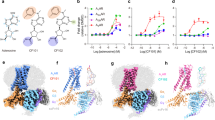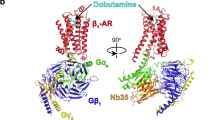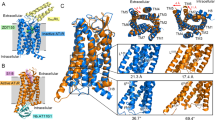Abstract
The class A adenosine A1 receptor (A1R) is a G-protein-coupled receptor that preferentially couples to inhibitory Gi/o heterotrimeric G proteins, has been implicated in numerous diseases, yet remains poorly targeted. Here we report the 3.6 Å structure of the human A1R in complex with adenosine and heterotrimeric Gi2 protein determined by Volta phase plate cryo-electron microscopy. Compared to inactive A1R, there is contraction at the extracellular surface in the orthosteric binding site mediated via movement of transmembrane domains 1 and 2. At the intracellular surface, the G protein engages the A1R primarily via amino acids in the C terminus of the Gαi α5-helix, concomitant with a 10.5 Å outward movement of the A1R transmembrane domain 6. Comparison with the agonist-bound β2 adrenergic receptor–Gs-protein complex reveals distinct orientations for each G-protein subtype upon engagement with its receptor. This active A1R structure provides molecular insights into receptor and G-protein selectivity.
This is a preview of subscription content, access via your institution
Access options
Access Nature and 54 other Nature Portfolio journals
Get Nature+, our best-value online-access subscription
$29.99 / 30 days
cancel any time
Subscribe to this journal
Receive 51 print issues and online access
$199.00 per year
only $3.90 per issue
Buy this article
- Purchase on Springer Link
- Instant access to full article PDF
Prices may be subject to local taxes which are calculated during checkout





Similar content being viewed by others
References
Fredholm, B. B., IJzerman, A. P., Jacobson, K. A., Linden, J. & Müller, C. E. International Union of Basic and Clinical Pharmacology. LXXXI. Nomenclature and classification of adenosine receptors—an update. Pharmacol. Rev. 63, 1–34 (2011).
Jacobson, K. A. & Gao, Z.-G. Adenosine receptors as therapeutic targets. Nat. Rev. Drug Discov. 5, 247–264 (2006).
Nguyen, A. T. N. et al. Role of the second extracellular loop of the adenosine A1 receptor on allosteric modulator binding, signaling, and cooperativity. Mol. Pharmacol. 90, 715–725 (2016).
Valant, C. et al. Separation of on-target efficacy from adverse effects through rational design of a bitopic adenosine receptor agonist. Proc. Natl Acad. Sci. USA 111, 4614–4619 (2014).
Cheng, R. K. Y. et al. Structures of human A1 and A2A adenosine receptors with xanthines reveal determinants of selectivity. Structure 25, 1275–1285.e4 (2017).
Glukhova, A. et al. Structure of the adenosine A1 receptor reveals the basis for subtype selectivity. Cell 168, 867–877.e13 (2017).
Liang, Y.-L. et al. Phase-plate cryo-EM structure of a class B GPCR–G-protein complex. Nature 546, 118–123 (2017).
Liang, Y.-L. et al. Phase-plate cryo-EM structure of a biased agonist-bound human GLP-1 receptor–Gs complex. Nature 555, 121–125 (2018).
Zhang, Y. et al. Cryo-EM structure of the activated GLP-1 receptor in complex with a G protein. Nature 546, 248–253 (2017).
Rasmussen, S. G. F. et al. Crystal structure of the β2 adrenergic receptor–Gs protein complex. Nature 477, 549–555 (2011).
Alexander, S. P. et al. The Concise Guide To Pharmacology 2017/18: G protein-coupled receptors. Br. J. Pharmacol. 174 (Suppl. 1), S17–S129 (2017).
De Lean, A., Stadel, J. M. & Lefkowitz, R. J. A ternary complex model explains the agonist-specific binding properties of the adenylate cyclase-coupled beta-adrenergic receptor. J. Biol. Chem. 255, 7108–7117 (1980).
Carpenter, B., Nehmé, R., Warne, T., Leslie, A. G. W. & Tate, C. G. Structure of the adenosine A2A receptor bound to an engineered G protein. Nature 536, 104–107 (2016).
Huang, W. et al. Structural insights into µ-opioid receptor activation. Nature 524, 315–321 (2015).
Kruse, A. C. et al. Activation and allosteric modulation of a muscarinic acetylcholine receptor. Nature 504, 101–106 (2013).
Rasmussen, S. G. F. et al. Structure of a nanobody-stabilized active state of the β2 adrenoceptor. Nature 469, 175–180 (2011).
Che, T. et al. Structure of the nanobody-stabilized active state of the kappa opioid receptor. Cell 172, 55–67.e15 (2018).
Erlandson, S. C., McMahon, C. & Kruse, A. C. Structural basis for G protein-coupled receptor signaling. Annu. Rev. Biophys. 47, 1–18 (2018).
Rosenbaum, D. M. et al. GPCR engineering yields high-resolution structural insights into β2-adrenergic receptor function. Science 318, 1266–1273 (2007).
Savinainen, J. R., Saario, S. M., Niemi, R., Järvinen, T. & Laitinen, J. T. An optimized approach to study endocannabinoid signaling: evidence against constitutive activity of rat brain adenosine A1 and cannabinoid CB1 receptors. Br. J. Pharmacol. 140, 1451–1459 (2003).
Liu, W. et al. Structural basis for allosteric regulation of GPCRs by sodium ions. Science 337, 232–236 (2012).
Rasmussen, S. G. F. et al. Crystal structure of the human β2 adrenergic G-protein-coupled receptor. Nature 450, 383–387 (2007).
Haga, K. et al. Structure of the human M2 muscarinic acetylcholine receptor bound to an antagonist. Nature 482, 547–551 (2012).
Manglik, A. et al. Crystal structure of the µ-opioid receptor bound to a morphinan antagonist. Nature 485, 321–326 (2012).
Rivkees, S. A., Barbhaiya, H. & IJzerman, A. P. Identification of the adenine binding site of the human A1 adenosine receptor. J. Biol. Chem. 274, 3617–3621 (1999).
Townsend-Nicholson, A. & Schofield, P. R. A threonine residue in the seventh transmembrane domain of the human A1 adenosine receptor mediates specific agonist binding. J. Biol. Chem. 269, 2373–2376 (1994)
Lebon, G. et al. Agonist-bound adenosine A2A receptor structures reveal common features of GPCR activation. Nature 474, 521–525 (2011).
Nguyen, A. T. N. et al. Extracellular loop 2 of the adenosine A1 receptor has a key role in orthosteric ligand affinity and agonist efficacy. Mol. Pharmacol. 90, 703–714 (2016).
Flock, T. et al. Universal allosteric mechanism for Gα activation by GPCRs. Nature 524, 173–179 (2015).
Stewart, G. D. et al. Determination of adenosine A1 receptor agonist and antagonist pharmacology using Saccharomyces cerevisiae: implications for ligand screening and functional selectivity. J. Pharmacol. Exp. Ther. 331, 277–286 (2009).
Oldham, W. M. & Hamm, H. E. Heterotrimeric G protein activation by G-protein-coupled receptors. Nat. Rev. Mol. Cell Biol. 9, 60–71 (2008).
Choe, H.-W. et al. Crystal structure of metarhodopsin II. Nature 471, 651–655 (2011).
Rose, A. S. et al. Position of transmembrane helix 6 determines receptor G protein coupling specificity. J. Am. Chem. Soc. 136, 11244–11247 (2014).
Ballesteros, J. A. & Weinstein, H. Integrated methods for the construction of three-dimensional models and computational probing of structure-function relations in G protein-coupled receptors. Methods Neurosci 25, 366–428 (1995).
Cleator, J. H., Mehta, N. D., Kurtz, D. T. & Hildebrandt, J. D. The N54 mutant of Gαs has a conditional dominant negative phenotype which suppresses hormone-stimulated but not basal cAMP levels. FEBS Lett. 443, 205–208 (1999).
Iiri, T., Bell, S. M., Baranski, T. J., Fujita, T. & Bourne, H. R. A Gsα mutant designed to inhibit receptor signaling through Gs. Proc. Natl Acad. Sci. USA 96, 499–504 (1999).
Lee, E., Taussig, R. & Gilman, A. G. The G226A mutant of Gsα highlights the requirement for dissociation of G protein subunits. J. Biol. Chem. 267, 1212–1218 (1992).
Posner, B. A., Mixon, M. B., Wall, M. A., Sprang, S. R. & Gilman, A. G. The A326S mutant of Giα1 as an approximation of the receptor-bound state. J. Biol. Chem. 273, 21752–21758 (1998).
Danev, R., Buijsse, B., Khoshouei, M., Plitzko, J. M. & Baumeister, W. Volta potential phase plate for in-focus phase contrast transmission electron microscopy. Proc. Natl Acad. Sci. USA 111, 15635–15640 (2014).
Khoshouei, M., Danev, R., Plitzko, J. M. & Baumeister, W. Revisiting the structure of hemoglobin and myoglobin with cryo-electron microscopy. J. Mol. Biol. 429, 2611–2618 (2017).
Khoshouei, M. et al. Volta phase plate cryo-EM of the small protein complex Prx3. Nat. Commun. 7, 10534 (2016).
Khoshouei, M., Radjainia, M., Baumeister, W. & Danev, R. Cryo-EM structure of haemoglobin at 3.2 Å determined with the Volta phase plate. Nat. Commun. 8, 16099 (2017).
Mastronarde, D. N. Automated electron microscope tomography using robust prediction of specimen movements. J. Struct. Biol. 152, 36–51 (2005).
Zheng, S. Q. et al. MotionCor2: anisotropic correction of beam-induced motion for improved cryo-electron microscopy. Nat. Methods 14, 331–332 (2017).
Zhang, K. Gctf: Real-time CTF determination and correction. J. Struct. Biol. 193, 1–12 (2016).
Tang, G. et al. EMAN2: an extensible image processing suite for electron microscopy. J. Struct. Biol. 157, 38–46 (2007).
Kimanius, D., Forsberg, B. O., Scheres, S. H. & Lindahl, E. Accelerated cryo-EM structure determination with parallelisation using GPUs in RELION-2. eLife 5, 19 (2016).
Arnold, K., Bordoli, L., Kopp, J. & Schwede, T. The SWISS-MODEL workspace: a web-based environment for protein structure homology modelling. Bioinformatics 22, 195–201 (2006).
Adams, P. D. et al. PHENIX: a comprehensive Python-based system for macromolecular structure solution. Acta Crystallogr. D 66, 213–221 (2010).
Emsley, P., Lohkamp, B., Scott, W. G. & Cowtan, K. Features and development of Coot. Acta Crystallogr. D 66, 486–501 (2010).
Chen, V. B. et al. MolProbity: all-atom structure validation for macromolecular crystallography. Acta Crystallogr. D 66, 12–21 (2010).
Burnley, T., Palmer, C. M. & Winn, M. Recent developments in the CCP-EM software suite. Acta Crystallogr. D 73, 469–477 (2017).
Brown, A. et al. Tools for macromolecular model building and refinement into electron cryo-microscopy reconstructions. Acta Crystallogr. D 71, 136–153 (2015).
Afonine, P.V. et al. New tools for the analysis and validation of Cryo-EM maps and atomic models. bioRxiv https://doi.org/10.1101/279844 (2018).
Pettersen, E. F. et al. UCSF Chimera—a visualization system for exploratory research and analysis. J. Comput. Chem. 25, 1605–1612 (2004).
Acknowledgements
This work was supported by the Monash University Ramaciotti Centre for Cryo-Electron Microscopy, National Health and Medical Research Council of Australia (NHMRC) project grant APP1145420 and NHMRC program grant APP1055134. A.C., P.M.S. and D.W. are NHMRC Senior Principal Research, Principal Research and Career Development Fellows, respectively. A.G. and D.M.T. are Australian Research Council Discovery Early Career Research Fellows. L.T.M. is an Australian Heart Foundation Future Leaders Fellow.
Reviewer information
Nature thanks D. Wacker and the other anonymous reviewer(s) for their contribution to the peer review of this work.
Author information
Authors and Affiliations
Contributions
C.J.D.-J. developed the expression and purification strategy, performed virus production, insect cell expression, purification, and membrane-based pharmacological assays, negative-stain electron microscopy data acquisition/analysis and prepared samples for cryo-EM; M.K. performed sample plunging for cryo-EM, phase-plate imaging and data collection, electron microscopy data processing and analysis; D.M.T. developed the expression and purification strategy, assisted with biochemistry, structure refinement and validation and model interpretation; Y.-L.L. and S.G.B.F. developed the strategy to generate the dominant-negative Gαi2; R.D. and W.B. organized and developed the Volta phase-plate cryo-EM data acquisition strategy; H.V. organized microscopy time and provided oversight of image acquisition within the Monash EM facility; J.M.P. provided advice on microscope setup for phase-plate imaging and EM facility access within the Max Planck Institute; A.T.N.N. and J.A.B. performed whole-cell pharmacological assays; L.T.M. supervised whole-cell pharmacological assays; C.J.D.-J., A.T.N.N., J.A.B. and L.T.M. performed data analysis; M.K., D.M.T., Y.-L.L., S.G.B.F., L.T.M., D.W. and P.M.S. assisted with data interpretation and preparation of the manuscript; A.G. developed the expression and purification strategy, performed negative-stain electron microscopy, cryo-EM sample preparation, model building, refinement and validation; C.J.D.-J., A.G. and A.C. wrote the manuscript; P.M.S., A.G. and A.C. supervised the project.
Corresponding authors
Ethics declarations
Competing interests
The authors declare no competing interests.
Additional information
Publisher’s note: Springer Nature remains neutral with regard to jurisdictional claims in published maps and institutional affiliations.
Extended data figures and tables
Extended Data Fig. 1 Expression and purification of the ADO–A1R–Gi2 complex.
a, Schematic of the haemagglutinin (HA) and Flag-tagged M4R-3C-A1R-3C-8×His construct. The most conserved residue for class A GPCRs (X.50 class A numbering34) are highlighted for each transmembrane domain in red. b, Purification step flowchart for the A1R–Gi2 complex. c, SDS–PAGE/western blot of samples obtained at various stages of A1R–Gi2 purification. A1R and the Gi2 heterotrimer were expressed separately in insect cell membranes. Addition of ADO initiated complex formation, which was solubilized by detergent. Solubilized A1R and A1R –Gi2 complex were immobilized on Flag antibody resin. Flag-eluted fractions were purified by size-exclusion chromatography (SEC). An anti-His antibody was used to detect Flag–A1R-His and Gβ-His (red) and an anti-Gi2 antibody was used to detect Gαi2 (green). d, SDS–PAGE/Coomassie blue stain of the purified complex concentrated from the Superdex 200 Increase 10/30 column. e, Left, representative elution profile of Flag-purified complex on Superdex 200 Increase 10/30 SEC. Right, SEC fractions containing A1R–Gi2 complex (within dashed lines) were pooled, concentrated and analysed by re-running on Superdex 200 Increase 10/30 column. All images and SEC profiles are representative of more than three independent experiments.
Extended Data Fig. 2 Pharmacology of the A1R construct and rationally chosen mutations.
a, b, Competition between the antagonist [3H]DPCPX and either unlabelled DPCPX (a) or ADO (b), in membranes expressing HA–Flag–3C-A1R-3C-8×His construct in the absence or presence of wild-type (WT) Gi2 heterotrimer or dominant-negative (DN) Gi2 heterotrimer. Data are normalized to [3H]DPCPX binding in the absence of unlabelled competitor, with nonspecific binding determined in the presence of 1 µM of the antagonist, SLV320. c, ADO-mediated binding of [35S]GTPγS as a measure of G-protein activation by the HA–Flag–3C-A1R-3C-8×His construct in High Five cells expressing receptor alone, or together with either wild-type or dominant-negative Gi2 heterotrimer. d, e, [3H]DPCPX competition assays (d) or inhibition of forskolin-stimulated cAMP accumulation (e), at the wild-type human A1R or two key alanine substitution mutations stably expressed in CHOFlpIn cells. f, Changes in agonist (NECA) affinity (Ki) from the experiments shown in d. g, Changes in NECA signalling efficacy corrected for receptor expression (τc), determined from the experiments shown in e. Parameter estimates are the mean ± s.e.m. determined from 3 (a–c) or 6–48 (d–g) independent experiments performed in duplicate. ****P < 0.0001 (compared with wild type; one-way analysis of variance (ANOVA), Dunnett’s post hoc test). Data for wild-type and N159A are replotted from Nguyen et al28.
Extended Data Fig. 3 Cryo-EM of the ADO–A1R–Gi2 complex.
a, Representative VPP cryo-EM micrograph (of 3,220 recordings) of the ADO–A1R–Gi2 complex. b, Reference-free 2D class averages of the complex in LMNG and CHS detergent micelles. c, Gold-standard Fourier shell correlation (FSC) curves, showing the overall nominal resolution at 3.6 Å. d, FSC curves for the final model versus the final map and the half maps for overfitting validation (see Methods).
Extended Data Fig. 4 Atomic resolution model of A1R transmembrane domains, the Gα protein α5-helix, ADO, and representative regions of Gβ and Gγ in the cryo-EM density map.
a, The molecular model is shown in stick representation and the cryo-EM map in mesh contoured at 0.06. b–d, A1R residues (b, c,) and Gαi2 α5-helix residues (d). The molecular model is shown in stick representation and the cryo-EM map in mesh contoured at 0.06.
Extended Data Fig. 5 Comparison of active and alternative inactive A1R (PDB code 5NS2) structure.
a–c, Side (a), extracellular (b) and cytoplasmic (c) view of the ADN–A1R–Gi2 structure (blue) compared to the inactive PSB36-bound A1R (grey). d, e, Active ADO–A1R (d) and inactive PSB36–A1R (e) receptor surfaces sliced to show binding site cavity. f, Orthosteric binding site of the active A1R–Gi2 complex with ADO (purple ball and sticks). ‘Toggle switch’ W2476.48 and residues within 4 Å of ADO are labelled and shown as sticks. Red rectangles highlight rotamer changes upon receptor activation. N, O and S atoms are coloured in blue, red and yellow, respectively. Dashed lines represent hydrogen bonds. g, GPCR motifs important for receptor activation (DRY motif, purple; NPXXY motif, blue; PIF motif, green).
Extended Data Fig. 6 Comparison of active A1R with active A2AR (PDB code 5G53) or agonist-bound ‘intermediate’ state A2AR (PDB code 2YDV).
a–j, Side views (a, f), extracellular views (b, g) and cytoplasmic views (c, h) of the active ADO–A1R–Gi2 structure (blue) compared to the active NECA–A2AR–mini-Gs structure (a–e) or ‘intermediate’ NECA–A2AR structure (orange) (f–j). d, i, Orthosteric binding site of the active A1R–Gi2 complex with ADO (purple ball and sticks) or A2AR with NECA (orange ball and sticks). ‘Toggle switch’ residue W6.48 and residues within 4 Å of ADO are labelled and shown as sticks. N, O and S atoms are coloured in blue, red and yellow, respectively. Dashed lines represent hydrogen bonds. e, j, Conserved class A GPCR motifs important for receptor activation (DRY motif, purple; NPXXY motif, blue; PIF motif, green).
Extended Data Fig. 7 Alignments of A1R with β2AR or dominant-negative Gαi2 with Gαs.
a, A1R alignment with β2AR. b, Gαs alignment with dominant-negative Gαi2. Key Ballesteros–Weinstein numbers are shown in red. Grey bars indicate the positions of the α-helices in the A1R–Gαi2 structure, whereas red bars indicate these regions in the β2AR–Gαs structure. Dominant-negative Gαi2 point mutations are highlighted in yellow.
Extended Data Fig. 8 Comparison of the A1R–Gi2 with β2AR–Gs structures.
Overlay of A1R–Gi2 with β2AR–Gs (PDB code 3SN6) complexes. (A1R–Gi2 is coloured as in Fig. 1; β2AR is in green, Gαs is in gold, Gβ is in light cyan, Gγ is in light purple).
Extended Data Fig. 9 View of key residues at the interface of A1R and Gβ, and Gα conformations.
a, A1R is in blue and Gβ is in dark cyan. b, c, Different views comparing DNGαi2 and Gαs from A1R and β2AR (PDB code 3SN6) receptor-bound structures (DNGαi2, pink; Gαs, gold). Spheres indicate the positions of the dominant-negative mutations on the DNGαi2 with N, O and C atoms coloured in blue, red and pink, respectively. The α5-helix bend and loops that are the most different between Gαi2 and Gαs are indicated.
Supplementary information
Rights and permissions
About this article
Cite this article
Draper-Joyce, C.J., Khoshouei, M., Thal, D.M. et al. Structure of the adenosine-bound human adenosine A1 receptor–Gi complex. Nature 558, 559–563 (2018). https://doi.org/10.1038/s41586-018-0236-6
Received:
Accepted:
Published:
Issue Date:
DOI: https://doi.org/10.1038/s41586-018-0236-6
This article is cited by
-
Binding kinetics drive G protein subtype selectivity at the β1-adrenergic receptor
Nature Communications (2024)
-
The activation mechanism and antibody binding mode for orphan GPR20
Cell Discovery (2023)
-
GPCRome-wide analysis of G-protein-coupling diversity using a computational biology approach
Nature Communications (2023)
-
Structural insights into the human niacin receptor HCA2-Gi signalling complex
Nature Communications (2023)
-
Prediction of dynamic allostery for the transmembrane domain of the sweet taste receptor subunit, TAS1R3
Communications Biology (2023)
Comments
By submitting a comment you agree to abide by our Terms and Community Guidelines. If you find something abusive or that does not comply with our terms or guidelines please flag it as inappropriate.



